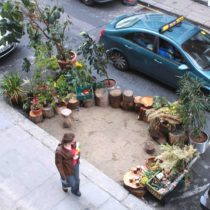Landscape Architecture for Landscape Architects › Forums › GRAPHICS › Getting Drawings from Tracing Paper to Standard Paper
- This topic has 2 replies, 1 voice, and was last updated 1 year, 4 months ago by
William Gonzales.
-
AuthorPosts
-
March 10, 2012 at 11:26 am #158473
 Dave AndrewsParticipant
Dave AndrewsParticipantI typically use hand drawn/rendered drawings for early stage presentations. My process is to develop my design on several layers of tracing paper (roll), and then lay over a clean sheet of trace and draw up my final version. I actually color on the trace (back side) and have it scanned to standard paper for the presentation.
This method carries the inherent risk of the trace getting jammed in a roll scanner. I’ve tried Vellum as a sturdier substitute to the trace but there are often grey “shadows” around the black lines which don’t appear on the standard thin trace versions.
Does anybody use this method or have recommendations for other methods (without using a light table to backlight a thicker piece of paper)?
Any thoughts or comments would be appreciated.
March 10, 2012 at 4:03 pm #158479 ncaParticipant
ncaParticipantI would suggest scanning the linework on a flatbed scanner if its not huge. Otherwise the large format scanner is kind of the only option and you do run the risk of ruining the drawing. Consider adding a sheet of bond with the trace taped securely to it.
To get rid of the dark shadows after scanning you need to get familiar with photoshop. I suggest using the ‘curves’ tool (ctrl+m). You can easily make the paper bright white and lines true black. Use ‘multiply’ to lay the linework over color and you can even do the color on a separate sheet of trace or in the computer.
Printing a copy of your linework before coloring on bond is the ideal option.
March 11, 2012 at 9:46 am #158478 AmanyParticipant
AmanyParticipantIn the office that i use to work in , we use the manual technique then we scan ( note the resolution size ) edit it in Photoshop for final presentation . And one of the first things that we do in Photoshop is to clean the lines of the traced paper ctrl + U , and have the line work on a separate layer then the rest of the work comes in different layers , trees, shrubs , ground covers , hardscape ,…etc .
March 11, 2012 at 9:57 pm #158477 Wyatt Thompson, PLAParticipant
Wyatt Thompson, PLAParticipantHaven’t you heard? Landscape architects don’t do concepts or grading by hand anymore…. so say the people who write the LARE….
March 12, 2012 at 6:58 am #158476Gabriel S. Metz
ParticipantI use the same technique as you describe. This is by far my favorite way to render plans. I can render quick and dirty just adding color or I can build up color layers creating depth. I like to render on the back while highlighting and shadowing on the front. I found that 13 pound trace works the best. It is heavier and more durable than the standard light weight trace and scans much better than vellum. I have scanned sheets for planning projects that are 60 plus inches long and 42 inches wide on a roll scanner. As long as I have good clean edges I don’t worry about it binding in the scanner. You may have to request the 13 pound trace at your art supply or reprographics store. The stuff I get is 42 inches by 150 feet. I believe the standard roll of trace is only 7- 8 pound.
I use curves in Photoshop as Nick describes to get rid of pencil and color pencil layout lines. Using curves I can get rid of all color lines and pencil marks without worrying about erasing them first. I have also scanned color trace rendering with a clean sheet of paper as someone else described. I found it is best to just tape the leading edge of the 2 sheets to reduce the chance of wrinkles and binding.
March 12, 2012 at 6:38 pm #158475 Les BallardParticipant
Les BallardParticipantYes, even for remaining smokers there are now so few brands of cigarettes with nice white shiny trays you can flatten, you have to waste a whole recycled envelope back on a sketch. I think some folk contributed to a thread a while back saying the magic and evidence of genius associated with drawing an idea for a client on a napkin over lunch, or whatever, has no equal but concluded that, while some still escape with hand drawing only, you have to produce something tarty that looks slightly professional at some stage. I have noticed that some landscapers may still translate what is in their heads with cans of paint on the ground, and using borrowed eyebrow pencils, on beermats, over meetings with project managers in the pub. Of course the client never sees anything of this and worries a lot, meaning the sense of relief when something decent results is tangible rather than them being supplied with a decent drawing in advance they can pick holes in ad infinitum. Maybe perfection lies somewhere in between, lol.
March 12, 2012 at 7:46 pm #158474 Thomas J. JohnsonParticipant
Thomas J. JohnsonParticipantOptions:
1. Tape Trace to standard paper before scanning.
2. Hang trace on white wall. Use Tripod and camera to capture image.
3. Use trace paper for presentation.
July 26, 2024 at 6:45 am #3565669William Gonzales
ParticipantHey there!
I totally get where you’re coming from. I also use hand-drawn/rendered drawings for early-stage presentations and have faced similar issues. Here’s my process, which might give you some new ideas:
I usually develop my design on multiple layers of tracing paper as well. Once I’m satisfied with the overall design, I place a clean sheet of tracing paper on top and draw up the final version. Instead of directly coloring on the trace, I flip it over and color on the back side, which I then scan to standard paper for the presentation.
However, like you, I’ve had issues with the trace getting jammed in the roll scanner. I experimented with vellum as a sturdier alternative but ran into the same problem with those grey shadows around the black lines.
One method that has worked for me is using a spray adhesive. I lightly spray the back of the final tracing paper and adhere it to a sheet of standard paper. This prevents the tracing paper from jamming in the scanner while maintaining the clean lines of the original drawing. After scanning, you can carefully peel off the tracing paper if you need to make adjustments.
Another option could be using a kraft paper roll. It’s a bit thicker and more durable than standard tracing paper, which might help with the jamming issue. Many kraft paper roll buyers use it for various art projects, and it could be worth trying for your design transfers.
I hope this helps! I’d love to hear if anyone else has other suggestions or methods that have worked for them.
Good luck with your presentations!
-
AuthorPosts
- You must be logged in to reply to this topic.


